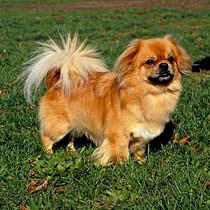|
The Canine Chronicles Directory
Tibetan Spaniel

The Tibetan Spaniel usually has long hair on the back of the legs and the shoulders
with an overall short coat. Males typically have a heavier coat than females. All
colors or mixture of colors are permissible, although the colors are usually gold,
cream, fawn, red, white, black, and black-and-tan. The slightly domed head is small
in proportion to the rest of the body. The stop is slight but defined and the muzzle
medium in length. The pendant ears are medium in size and set high on the head.
The oval-shaped eyes are usually dark brown, the nose black and the mouth slightly
undershot. The strong neck should be moderately short and the length of the body
should be longer than the height of the withers. The back is strong with well-sprung
ribs. The shoulders are firm and the moderately boned legs slightly bow. The hindlegs
have well let down hocks as well as a moderate stifle. The small, cat-like feet
are round and have feathering between the toes. The high set tail is plumed and
is carried over the back.
|
|
Temperament
|
Tibetan Spaniels are intelligent, sweet, happy and trusting. They are very loyal
and protective towards their families, especially the children. They are generally
wary around strangers and will alert their families in case of intruders or strange
noises. They usually get along with other household pets as long as they've been
raised with them. This breed is fairly independent. They can also be insistent and
willful on occasion.
|
|
Height, Weight
|
Height: 10" ; Weight: 9-15 lbs.
|
|
Health Problems
|
Though a very healthy breed, they are prone to overheat and have respiratory problems.
|
|
Living Conditions
|
The Tibetan Spaniel is good for apartment living and will do fine without a yard.
|
|
Exercise
|
This breed enjoys long walks and romps in the yard.
|
|
Life Expectancy
|
About 12-15 years
|
|
Grooming
|
This breed's hair comes out in clumps once a year. Brush regularly. They are average
shedders.
|
|
Origin
|
Tibetan Spaniels originated from monasteries and villages located in the Himalayan
Mountains. Their love of lofty views and keen eye sight made this breed an excellent
guard dog for these isolated areas. Tibetan Spaniels were highly regarded companions
by the monks. During the winter months, they would place a dog under their robe,
benefiting from each other's warmth. These dogs were also reportedly used to turn
prayer wheels at the monasteries. Tibetan Spaniels were highly prized in ancient
Tibet and often used as gifts to royal households. Due to this, the breed spread
throughout Asia. Breeding was not discriminate at the time and many of the breed
was crossed with Chin, Pekingese, and other Oriental breeds. A breed similar in
appearance to the Tibetan Spaniel was found on Chinese bronzes, which would date
the breed as far back as 1100 BC. The first record of the Tibetan Spaniel in England
was in 1895, when a sailor returned from the Middle East with the breed. English
breeders were slow to take interest and after World War I the breed was nearly extinct.
It wasn't until Lady Wakefield received a Tibetan Spaniel as a present in India
and bred it with an import from a Western Tibetan Tashi-Gong Monastery that a true
program began. A litter was produced in 1941 and subsequently brought to England
in 1946. The breed was officially recognized by the AKC in 1984 and by the UKC in
1992.
|
|
Group
|
AKC Non-Sporting, UKC Companion Dog
|